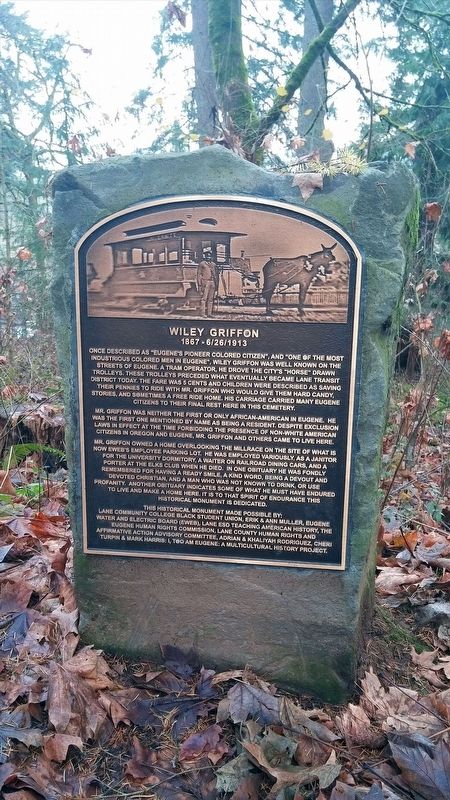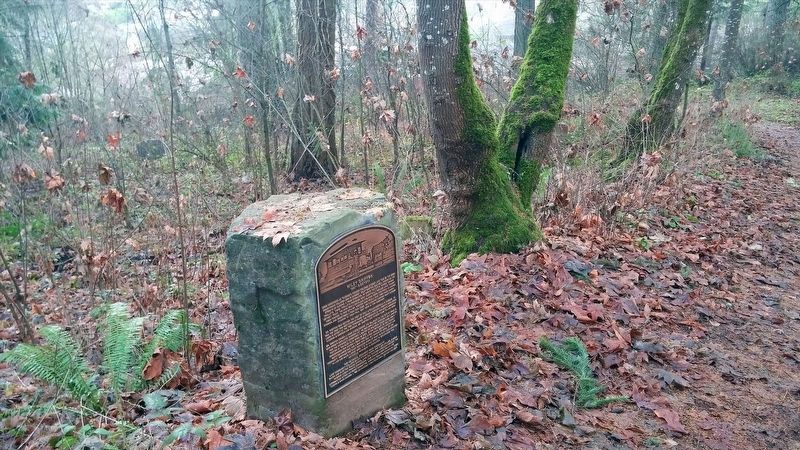Eugene in Lane County, Oregon — The American West (Northwest)
Wiley Griffon
1867 - 6/26/1913
Mr. Griffon was neither the first or only African-American in Eugene. He was the first one mentioned by name as being a resident. Despite exclusion laws in effect at the time forbidding the presence of non-white American citizens in Oregon and Eugene, Mr. Griffon and others came to live here.
Mr. Griffon owned a home overlooking the Millrace on the site of what is now EWEB's employee parking lot. He was employed variously, as a janitor for the university dormitory, a waiter on railroad dining cars, and a porter at the Elks Club when he died. In one obituary he was fondly remembered for having a ready smile, a kind word, being a devout and devoted Christian, and a man who was not known to drink, or use profanity. Another obituary indicates some of what he must have endured to live and make a home here. It is to that spirit of endurance this historical monument is dedicated.
Erected by Lane Community College Black Student Union, Erik & Ann Muller, Eugene Water and Electric Board (EWEB), Lane ESD Teaching American History, the Eugene Human Rights Commission, Lane County Human Rights and Affirmative Action Advisory Committee, Adrian & Khaliyah Rodriguez, Cheri Turpin & Mark Harris: I, Too Am Eugene: A Multicultural History Project.
Topics. This historical marker is listed in these topic lists: African Americans • Railroads & Streetcars.
Location. 44° 1.925′ N, 123° 4.446′ W. Marker is in Eugene, Oregon, in Lane County. Marker can be reached from East 25th Avenue. Touch for map. Marker is in this post office area: Eugene OR 97403, United States of America. Touch for directions.
Other nearby markers. At least 8 other markers are within 2 miles of this marker, measured as the crow flies. Ellis F. Lawrence (about 600 feet away, measured in a direct line); Petrified Wood (approx. 0.8 miles away); Granite Glacial Erratic (approx. 0.8 miles away); The Collier House (approx. 0.9 miles away); Patterson Home Site / Animal House (approx. 1.1 miles away); A.W. and Amanda Patterson Home (approx. 1.1 miles away); American Nobel Peace Laureates (approx. 1.8 miles away); Theodore Roosevelt (1906) (approx. 1.8 miles away). Touch for a list and map of all markers in Eugene.
More about this marker. Marker is located in the northern quadrant of Eugene Masonic Cemetery.
Regarding Wiley Griffon. The location of Wiley Griffon's grave was lost many decades ago in this cemetery. This monument has been placed here to remember his legacy for visitors to enjoy.
The Eugene Water and Electric Board (EWEB) website contains additional info on Wiley Griffon and tells us: Wiley Griffon is widely considered to be Eugene’s first African-American resident. Well- known and popular, Griffon was the driver and de facto operator of a mule-driven streetcar service that carried early residents from West Eugene to the University of Oregon campus. A Sanborn map from 1912 shows Griffon’s house to be located near the intersection of 4th and Mill Street, on the riverfront property near to the present-day EWEB Employee’s Credit Union. On Eugene Skinner’s first plat, Griffon’s residence is located on Block 10, Lot 4.
Born in 1867, Griffon came to Eugene from Texas in 1891 with Henry W. Holden, the railway entrepreneur who employed him. Wiley died in Eugene in 1913, at age 46, and was buried in the Masonic Cemetery among Eugene’s other pioneer citizens. The location of his grave in the Masonic, and the fact that the local Elks paid for his funeral, says a great deal about the respect Griffon earned during his 22 years as a member of Eugene’s community. By all accounts, he was a well-liked, respected man who made recognized contributions to the daily lives of others. He worked for many businesses during his time in Eugene, and purchased his small home overlooking the Millrace in 1909. It is a simple story of a popular man made remarkable by that fact that Griffon lived in Eugene at a time when Oregon laws still barred African-Americans from residing in the state.
At the time Griffon lived on the EWEB property, Oregon could hardly have been a welcoming place for African-Americans. In 1844, the Territory government had banned slavery but made it illegal for African-Americans to live within its bounds. Oregon reaffirmed its exclusion laws when the state constitution was ratified in 1857. In 1859, Oregon was the only state in the union that still had exclusionary laws on its books. These laws weren’t repealed until 1926, and it wasn’t until 1959 that Oregon ratified the 15th Amendment of the U.S. Constitution, almost 90 years after it was approved by the Federal Government.
As the first recorded of many African-American pioneers in Eugene, and as the city’s first known public-transit provider, Wiley Griffon’s is an important story to share through the design of this interpretive landscape. Griffon’s house also operates as a connecting point between two adjacent sites of historic significance to the African-American community: the Mims House and Ferry Street Community site.
Credits. This page was last revised on January 20, 2018. It was originally submitted on January 17, 2018, by Douglass Halvorsen of Klamath Falls, Oregon. This page has been viewed 574 times since then and 114 times this year. Photos: 1, 2. submitted on January 17, 2018, by Douglass Halvorsen of Klamath Falls, Oregon. • Bill Pfingsten was the editor who published this page.

